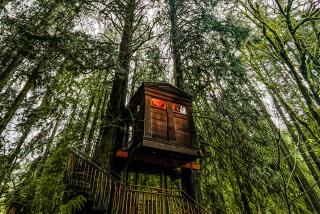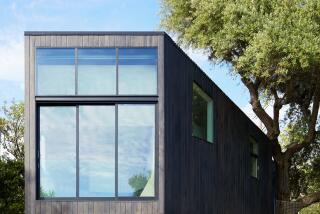In Big Sur, indulge in quiet luxury at the Post Ranch Inn
At the Post Ranch Inn in Big Sur, the white noise of 21st century life recedes as a Lexus hybrid SUV quietly carries visitors to their rooms, a collection of cottages that nestle along redwood-lined cliffs overlooking the Pacific. The cottages--”treehouses” clad in aged wood and set atop 9-foot poles in stands of Douglas fir; curved steel enclosures with the rusty patina of Richard Serra sculptures; and modern spaces with sod roofs and clean lines--blend into the landscape. The elements seem to be slowly reclaiming them.
Inside the rooms, the understated décor seems meant to be eclipsed by uninterrupted views of treetops and ocean expanses. A half-day’s drive from Los Angeles, this is the face of high-end green luxury. Luxury, above all, that manifests itself as a profound sense of place.
“Everything about the property makes you want to appreciate nature,” says second-time visitor Jeff Eisenberg of Westlake Village, who came to celebrate a wedding anniversary. “It fits into the land so well that you don’t even see the buildings.” Adds his wife, Janet: “You feel like you’re the only people here.”
Post Ranch has long been a regular presence on lists of top luxury hotels, best spas and most-romantic getaways. And with the recent addition of 10 new cottages to the original 30 spread over 100 acres, the resort has continued to refine its underlying model of green business, weaving its environmental consciousness and social responsibility into the experience it offers guests.
This isn’t preachy green. Thus, in most discussions of the property’s cozy spa, elegant restaurant, complimentary organic minibars, spacious rooms and extensive list of organic and biodynamic wines, it’s nurturing guests, not protecting nature, that consumes the conversation. But every detail has a green story.
Inside the newest rooms, by Los Gatos, Calif., architect Vladimir Frank, the rich patina of the wood paneling comes from, of all things, wine--enormous redwood wine vats were disassembled and milled into boards. The rooms’ whimsical lamps by artist Jim Misner are made from recycled plumbing parts. And new technologies subtly adjust comfort levels as they invisibly conserve resources. The concrete floors, stained to resemble stone, are warmed by an energy-efficient radiant heating system that circulates hot water through embedded coils. In summer, rooms stay cooler with remote-controlled, translucent sunshades that don’t block the view. When the sliding glass doors are left open, a magnetic switch triggers the shutdown of the heating and cooling system.
Slip into the tall king-size beds and you notice that the sheets have heft but are soft, like a well-worn T-shirt. The organic Coyuchi towels and bed linens are also part of a self-sustaining cycle: They’re laundered on-site (with natural detergents) to limit transportation, pollution and excess wear by outside laundries. The water used in the process is filtered and irrigates the landscape of native and drought-tolerant plants. The lofty mattresses are made of wool and other natural materials that require no chemical fire retardants.
What visitors notice is comfort that doesn’t call attention to itself or its thread count, a departure from usual connotations of luxe. “You have to be careful with the word ‘luxury,’ ” says the resort’s co-founder Mike Freed, “because a lot of people think of luxury as big-screen TVs and more of the ‘Yes sir, yes ma’am’ type service.
“It’s a funny word. On a lot of levels we don’t think of ourselves as luxury,” he says, groping for a better label. “It’s that rustic elegance we try to combine with what we do.”
the inn’s basic green practices--its use of sustainably harvested and renewable building materials, recycling programs and organic food--have been in place since 1992, when Freed developed the resort with Joseph William “Bill” Post III, the great-grandson of Big Sur settler William Brainard Post, whose ranch spread over 1,500 acres of ocean-view property beginning with an 1860 homestead.
Bill Post, now 87, insisted on a few things as plans for the inn went forward: the purchase of a new tractor, the chance to prepare the sites himself (only one diseased tree was felled) and the naming of the rooms for Big Sur settlers. (The newest rooms honor local women pioneers because, he says, “they did most of the work,” and all the rooms feature photos and descriptions of their namesake settlers--a way of maintaining a connection.) With the homesteaders as inspiration, the inn’s founders are trying to demonstrate how to live harmoniously on the land. “We’re trying not to compete with nature,” Freed says. “It’s the back-to-nature movement done in an upscale way.”
Their effort is guided by a published code of environmental and social responsibility that emphasizes the health and well-being of guests, employees and their surroundings. In concrete terms, it means buying local, supporting manufacturers with similar values and planning for long-term sustainability, not short-term profit, says Freed, who’s lived off the grid in a solar-powered home on a Big Sur hilltop for about 30 years.
Through the resort’s life, it’s tapped new technologies as they’ve become available. Three years after it opened, the inn installed a commercial graywater system to help reduce water consumption, and the next planned project is a game changer: a $1.8-million solar photovoltaic power system, now in the permit stage, that Freed says would be the largest solar energy system in any mainland hotel.
Freed and General Manager Dan Priano use sustainable practices throughout the property. The wood-chip mulch around plantings is harvested from the 50-acre forest’s fallen trees, which are also burned in guest room fireplaces. Closets contain recycling bins. Wastebaskets are lined with sheets of newspaper, and signs requesting privacy are printed on recyclable magnetic cards that won’t blow off and become litter.
When you dine at Sierra Mar, the resort’s restaurant, you’ll find an extensive seasonal menu in which 60% to 70% of the produce is organic, says executive chef Craig von Foerster. Sometimes the goods are exceedingly local--he can pluck herbs from the restaurant’s earthen roof. A former pasture will become an organic garden when an employee finishes building the stone walls.
Von Foerster wastes nothing. Fruit left from the complimentary breakfast buffet is cooked into jam and marmalade. Used deep-fryer oil goes to the local biodiesel cooperative. Waiter Trevor Meeker drives his converted Dodge diesel truck to work on the fuel and has Von Foerster save interesting cans and labels for his collage artwork. The chef and a Santa Cruz artist are collaborating on new glass plates. “If we break them, we can send them back for him to reuse,” Von Foerster says.
People and social causes figure prominently in the green mission. The handmade floor rugs in the new rooms are from Tufenkian Artisan Carpets, a company that uses profits to fund humanitarian projects. Most of the inn’s furniture and cabinetry are crafted on the property by master woodworker Mark Sullivan. His presence underlines the founders’ respect for heritage: Sullivan is the adopted son of Mary Post Fleenor, Bill Post’s sister and founder of the original Sierra Mar restaurant.
Employees receive benefits that include tuition reimbursement, flex time, child-care assistance and annual bonuses. Ninety of the 175 employees live just down the road from the yoga yurt in subsidized apartments built to blend into the environment. One upshot of these programs is a contented, stable workforce. On a recent visit it was rare to encounter anyone who’d worked there fewer than five years, and all seemed eager to convey their pride of place.
Post Ranch Inn pays for its innovations with some of the country’s highest room rates-- $550 to $2,185--yet has a 90% occupancy rate.
“We’re lucky because we charge a little more, so we can pay a little more” for our products, Freed says. “The perfect example is organic cotton sheets and towels. They’re at least 25% more expensive than the equivalent, but I think our guests appreciate that they’re organic but still very good quality.”
Not every green-minded innovation has worked. Priano grimaces at the mention of five 7-foot granite boulders carved into hot tubs. Several cracked, leaked and became what may be the most expensive flower planters in history.
The inn has had to navigate one of the strictest regulatory environments in the state, says California Coastal Commission member and Monterey County Supervisor Dave Potter. He calls the hotel’s adherence to Big Sur’s land-use plan “exemplary”; it often preempts the need for additional government oversight. “They are in the process of taking the hotel off the grid and making it solar. No one is forcing them to do it. It’s totally volunteer. That’s a classic example of what they do,” he says.
Post recalled at one of his weekly lectures that getting to this point wasn’t easy. It took six years to obtain the many permits required to build in the area, home to the endangered Smith’s blue butterfly, the threatened California red-legged frog and the once nearly extinct California condor.
“After all that permit business, I said, ‘Let’s forget it,’ ” Post said. “But Mike said, ‘No, no. Just be patient.’ So that’s why we’re here.”
That attitude may be the latest lesson in luxury living: If you want things to last, you can’t be in a hurry. Not that the notion of hurrying seems possible as you step onto a private deck at sunset with a glass of organic wine, immersed in the changing colors of the water and sky, drinking it all in. *
More to Read
Sign up for The Wild
We’ll help you find the best places to hike, bike and run, as well as the perfect silent spots for meditation and yoga.
You may occasionally receive promotional content from the Los Angeles Times.






